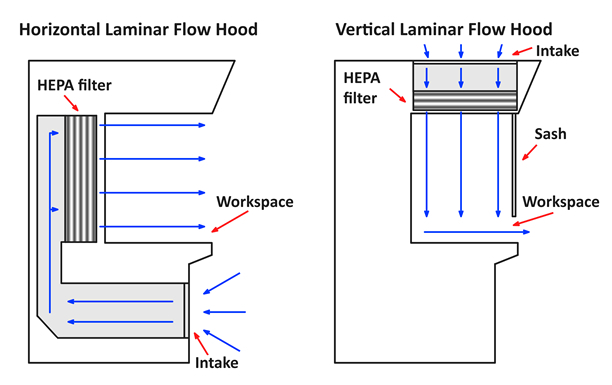ドラフトチャンバーと層流キャビネット
概要
ロバート ・ m ・ Rioux ・ ウィリアム a. エリオット、ペンシルバニアの州立大学、大学公園、PA
ドラフトチャンバー流キャビネットと同様の原理で動作するコントロールの技術です。両方は研究室環境とその住民の汚染を防ぐために一定の空気の流れを使用します。流キャビネット キャビネットのワークスペースを入力から汚染を防ぐために対しヒューム フードはフード ワークスペースを終了から有害物質を防ぐ。
ヒューム フードは、有害蒸気、ガス、粒子への暴露を最小限に抑えるために設計された換気システムです。一定の空気の流れを開く、蒸気、ガス、および粒子のエスケープを限定するフードに引き込まれ、排気を取り出したが。流キャビネットが常に流れることによって滅菌/クリーン環境を維持するために使用される高効率微粒子取り押さえ (HEPA)-フィルターの空気の外側、キャビネットのワークスペースに入る汚染された空気を最小限に抑えます。HEPA フィルターの空気は、研究室に入るから有害な化学物質や粒子のための機会を低減します。99.97% 除去の HEPA フィルター 0.3 μ m 粒子の。
手順
1. ヒューム フード
- 使用してください。
- ヒューム フードは、有害な蒸気、煙、または微粒子のシリカ粉末やベンゼンなどの揮発性発癌物質などの浮遊粒子物質を生成するときに使用されます。
- 操作
- 空気を描画すると、フードの開口部に直面するユーザーが動作しても排気します。一定流量の空気の顔に向かって内側を防ぎます有害蒸気、ガス、および粒子ユーザーや他の研究所の労働者の安全を守るフード開口をエスケープします。
- 顔射の流れの速度は十分に高い効果を発揮するフードの必要があります。低流速では、有害なガス、蒸気、またはユーザーに向かってフードの開口部を通って脱出する粒子をことができます。低流速の原因の 1 つは、フード開口部、サッシ、高すぎると呼ばれる調節可能なウィンドウをことです。ヒューム フード低速度アラームの流れし、サッシ高さアラームを持っているが一般的です。典型的な流速は 0.41 と 0.51 m/s (ANSI/万城目/ASSE Z9.5) 間です。フードは、明確にマークされているサッシの最大安全作業
申請書と概要
参考文献
- American National Standard for Laboratory Ventilation," American National Standards Institute, Inc./ American Industrial Hygiene Association, ANSI/AIHA Z9.5, 2012.
タグ
スキップ先...
このコレクションのビデオ:

Now Playing
ドラフトチャンバーと層流キャビネット
Lab Safety
68.6K 閲覧数

適切な個人用保護具
Lab Safety
234.0K 閲覧数

緊急時の洗眼、シャワー ステーション
Lab Safety
82.3K 閲覧数

電気的安全性
Lab Safety
42.0K 閲覧数

遠心分離機の操作
Lab Safety
95.6K 閲覧数

ホットとコールドのソースの操作
Lab Safety
41.4K 閲覧数

研究所緊急ガイドライン
Lab Safety
182.5K 閲覧数

化学ストレージ: カテゴリ、危険性と互換性
Lab Safety
108.4K 閲覧数

無機酸の安全な取り扱い
Lab Safety
44.7K 閲覧数

取り扱い化学物質の流出
Lab Safety
87.4K 閲覧数

オートクレーブの適切な使用
Lab Safety
87.5K 閲覧数

シュレンク管を使用して空気に水敏感な化学薬品を扱う
Lab Safety
21.9K 閲覧数

真空の適切な操作ベースの機器
Lab Safety
15.8K 閲覧数

グローブ ボックスの操作
Lab Safety
28.7K 閲覧数

高圧容器の操作
Lab Safety
16.1K 閲覧数
See More
Copyright © 2023 MyJoVE Corporation. All rights reserved
